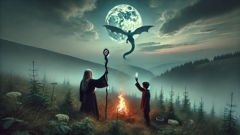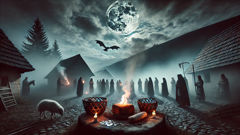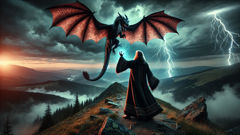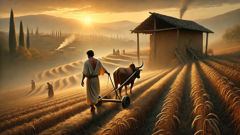Introduction
High in the folded ribs of the Carpathians, where ridges cut the clouds and rivers remember the sound of glaciers, the wind has always been somebody’s story. Villagers tell it as a voice that bargained for the rain, as a rider who crossed the thunderhead like a man on horseback. They call that rider a Solomonar: part sage, part sorcerer, mounted on a long-bodied dragon that men name balaur, whose scales are like hammered copper and whose breath tastes of iron and salt. In remote pastures and in hamlets ringed by beech and fir, people hum songs that ask mercy of this figure. They leave wool and bread on the threshold, they stitch a coin into a child's shirt, they place a sheepskin at the crossroads; these are small tributes, but they are offered not to a king or a priest but to the one who can lift a drought or scatter a hailstorm. The Solomonari, the old tales say, do not work for man: they watch the vault of weather as if it were a ledger, and sometimes they amend the accounts. They learned their craft in hidden places—under mountain chasms, by the mouths of deep wells, in overnight dream-classes taught by figures whose names shift like wind: saints, fallen angels, lonely hermits, or simply the clever boys who accepted the cost. The cost, the songs warn, is never small. A Solomonar will take for his lesson a promise, a secret, a piece of a man’s soul, or a last-year’s moon carved into bone. In exchange he gives the knowledge to summon clouds, to coax lightning into a lane, to smooth the summer sky or to yank a storm over a rival valley. The result is a world where weather is not mere happenstance but a currency, and where every thunderclap can be read like a message. This tale walks both the high ridge and the muddy lane. It traces the Solomonari’s deep roots in Romanian folk memory—their origin myths, their dragon companions, their rituals of tribute—and follows a single village caught between fear and defiance, between offering and revolt. In the telling, the mountains keep their secrets and the horizon learns to bargain anew.
Origins, Apprentices, and the Dragons of the Sky
The oldest songs about the Solomonari begin with a question that never ages: where does a winter begin, and who taught a man to shape it? In the high tales, a Solomonar is born twice. He is born in the ordinary way, in a house of wood and clay, and then he is reborn on the stone where the wind goes to sharpen itself. The rebirth comes as an impossible apprenticeship: an encounter by a well, an invitation on a night when the moon is a thin coin, a child chosen by accident or hunger. Legends point to known places—Ceahlău's rough crown, the shrouded folds of Bistrița's forests, the lonely hollows of Bucegi—where apprenticeship happened beneath stars that seemed to lean close enough to listen. Those who remember the tales with seriousness say the teacher could be a thin old man whose beard had the white of lightning, or a woman whose laugh began like thunder. Sometimes the teacher wasn't a person at all but a thing: an ancient book bound in hide, a whistle carved from the throat-bone of a great bird, a ring of blackened iron left on a slab of granite. The initiation, always, demanded a cost. A youth might give up a name, or consent to a silence that lasts until the final hail. In some pockets of the country, it is said an apprentice must steal a blade of grass from the highest meadow at noon, bring it to the black mouth of a cave, and speak a name that has no vowels. The test is rarely violent; its cruelty is subtler: the student learns patience, the habit of listening to the wind as if it were speaking in code. Once instructed, the Solomonar learns the ledger of skies. This is not just a matter of waving hands; it is the deliberate arranging of symbols, of stones, of songs. They learn to read the language of cloud: the low, fat bank that promises rain; the thin fair-weather filament that betrays humidity; the jagged mouth of a cumulonimbus that wants to be a storm. They mix herbs—mugwort for calling, thyme for quiet, juniper for turning away frost—and they understand how to knit these with ritual motions. The dragons they ride, the balauri, are neither the mindless monsters of simple storybooks nor the cultured companions of courtly romance. The balaur belongs to the older grammar of Eastern European myth: a many-headed figure in some tales, a solitary long-bodied dragon in most Romanian recollections. Its belly is a seam of heat over which the night’s breath gathers; its wings are pages of shadow that can blot a moon. It will accept a rider only if certain conditions are met: a pact sealed with blood or bread, a night watch shared beneath a storm, an offering of iron left on a ridge. Riders and dragons form partnerships that are less ownership than partnership: the rider brings cunning and the balaur brings raw weather. Together they work as a single mind. The power to command a storm is described like music in old accounts. A Solomonar will stand on a ridge and sing a pattern of syllables, some borrowed from Church liturgy and others wholly dark. He will throw handfuls of salt to the wind like a scatter of coins, beat a hand drum whose rhythms match the heartbeat of the valley, or clasp a copper rod that conducts the cloud's hunger. The dragon responds with a roll of smoke, a shrug of its wings, a howl that bends the air. A small rain might follow, enough to gladden a plow; a great storm could be turned loose on an enemy hamlet. In this world, weather is a story made manifest; it is not neutral but a speech act directed by those who learned its grammar. Folk scholars trace the notion of the Solomonari to several streams of cultural memory. The name itself has shifting roots. Some connect it to Solomon—as if the archetypal wise ruler were borrowed and refashioned—linking biblical authority to local magic. Others suggest a distant Turkic influence or a synthesis of Byzantine and pre-Christian beliefs. What remains clear is the social role: Solomonari stood at a junction between natural power and human need. Villagers depended on them, feared them, and tried to influence them. They were ominous presences in folk-law: a figure who could be courted in lean years and resented in seasons of bounty. Their ambivalence is not accidental. The Solomonari are not bound to a single moral ledger; they are agents of unpredictability. In some stories a Solomonar is a protective figure who shelters a valley from storms and lends rain in summer; in others he is capricious and proud, imposing demands that impoverish the poor to keep the clouds at bay. That duality is essential to their cultural meaning: they personify weather's double face, the same force that feeds and that destroys. The complicated relationship between villagers and Solomonari also shaped local practices of tribute and appeasement. Offerings were not always simple. A village might stitch a child's first coin into the hem of a shirt, or send a sheepskin and the best loaf to a crossroads where the rider was believed to pass. Neighborhoods would hold a minimal feast in the name of the Solomonari whose mood they needed to placate: an animal sacrifice in older times, an egg and a braid of onions in later folk practice. The tribute served several functions. On the pragmatic level, it was insurance: the community pooled a small wealth to hedge against drought or hail. On the symbolic level, the act acknowledged the boundary between human and elemental powers; it was a ritual of humility that marked the village's place in larger forces. The Solomonari's ability to demand tribute also turned him into a social regulator: he could punish a village that had become arrogant or too wasteful, or he could be bribed by the ambitious headman of a rival hamlet. Folktales are full of clever people who outwit a Solomonar, stealing his rod or tricking his dragon into leaving the mountain, but these tales function more as instruction than fantasy. They teach how communities imagine resistance and negotiation with an unpredictable world. A boy who learns a Solomonar's secret may not become a hero; often he pays with memory, love, or a piece of himself. The origin stories and the apprenticeship rites thus tell us not only about supernatural practice but about the moral economy of a people who lived close to the edge of weather's whim: how they turned fear into ritual, how they made bargains out of rain.

Tributes, Bargains, and the Village That Wouldn’t Bend
Not every village accepted its role in the ledger of weather. Some communities—clustered near fords, perched beside terraces of grain—refused to pay what they understood as blackmail. Stories of defiance travel differently than songs; they carry names, dates, the crispness of scandal. One such tale belongs to a narrow valley where the Bistrița river runs cold and the fields hug the base of a cedar slope. The place, in the telling, is exemplary: a village with stubborn men and clever women, with an old mayor who read maps and a schoolteacher who preferred books to superstitions. They had grown prosperous enough to resent the ritual tribute that neighboring hamlets paid out of necessity. The Solomonar who had claimed their sky had no taste for being ignored. That Solomonar was known in whispers as Ilie Cuceritor—a name that made parents hush children when thunder walked over the roofs. Ilie wore a mantle of dark wool and rode a dragon whose wings were patched with scars; his eyes had the blue of a winter brook. The villagers began with small provocations: chickens left unoffered, the bell on the crossroads rung differently, bread carried as alms to the Orthodox split and burned rather than placed whole. They thought of these acts as artistic protest against an ancient extortion. They did not imagine the ledger’s response. On the morning the first retaliation came, the sky was a mute cloth of low gray. The Solomonar did not need to raise his voice; the dragon's shadow fell across the valley like a sentry. A line of hail the size of coins marched down between the rows of cabbage, slicing young leaves. A third of the sheep in the upper pastures lost their fleece. After that, the village divided itself along quieter but crueler lines. Some argued that submission was the only reasonable path: that tribute was insurance, and that a penny’s loss now prevented ruin later. Others said the community should fight—collectively, not in private bribes—and bargain for a different arrangement. Into that fracture stepped Ana, a woman of the village whose husband had lost two lambs in the hail. She had a voice steady enough to be heard at the council and a temper that matched the river in flood. Ana proposed a new ritual: instead of leaving gifts that vanished into the hands of a single rider, the villagers would gather their offering as a public fund to be used for the common good—repairing roofs damaged by wind, buying seed to replant a ruined crop, lighting lamps in winter for those without. In effect, she proposed to transform the tribute from private appeasement into communal insurance. The idea was modern and dangerous. The Solomonar, accustomed to the private exchange of favors, might see it as insolence or theft; his code favored those who understood the individual bond. Yet there was also wisdom in Ana's plan; it recognized that weather struck without respect for social rank, and that pooling resources made a village resilient. The first meeting to enact the new ritual occurred on a night when the moon was a thin blade. The village laid three things at the crossroads: a loaf, a bottle of plum brandy, and a pile of small coins wrapped in linen. The teacher read an old doina—an unmetered song that asks the sky for leniency—and several women burned herbs to make a bitter smoke. The town did not try to hide the offering. It left a public note: the gifts were for the valley's safety, offered to no man alone. The following morning, the sky had changed. Clouds rolled like hemmed curtains; a gentle rain fell for an hour and then stopped. Fields that had been bone-dry took on the sheen of promise. There was jubilation, and many believed the new ritual had worked. But the ledger is never entirely satisfied with a single payment. Ilie’s anger was patient. In the months that followed he targeted the wealthiest family in the village—the family that had refused the fund from the start, who continued to send secret gifts to other Solomonari rumored to travel under the hills. One night he sent a fury of wind to the windows of that family's house. Sacks of grain split open. The family, who had thought themselves above custom, learned to respect the communal bargain. The tale becomes more complicated when a child disappears and is later found at the dragon's lair without a name. That detail, recurring in many versions, introduces a weightier question: what does a community owe the powerful beings who guard its weather, and what do those beings owe in return? In some versions, the child is returned unharmed and the Solomonar accepts the new arrangement, perhaps because he has a hidden affection for the village’s resilience. In others, the child’s silence is the price of the pact, and their remembered absence becomes the village’s moral stain. Folklore keeps both endings alive because they teach different lessons. The more hopeful version affirms negotiation: the Solomonar can be brought into a covenant where he protects the valley fairly, and tribute becomes a mutual obligation. The darker version warns of the moral hazard hidden in bargains with powers we do not control: to secure advantage for the many, the community might yield a child's laughter or a mother's memory. The story’s richness lies in the way it explores the economy of risk, faith, and accountability. The villagers who share a roof must also share the damage when weather turns against them; neither private bribery nor private vengeance alone will create safety. The ritual that Ana introduced—public, transparent, aimed at common repair—emerges as a form of civic religion. It formalizes reciprocity and makes the Solomonar's power into something that can be negotiated with a collective voice rather than bought behind closed doors. This is not to say the Solomonari vanish. Even after the fund's establishment, pockets of superstition persist. Some families keep secret embroideries tucked into chests—coins sewn into shirts, charms pressed beneath stove bricks. Some youths still dream of the dragon and try to learn the old syllables, eager for mastery. But the fund matters; it shifts expectation. When a storm tears off a roof, the community's money mends it; when hail shreds a field, seed is purchased together. Over time the village becomes an example to others, and the tale of its bargain spreads. Towns nearby copy the practice, altering ritual according to local custom. Some add a bell at the crossroads; others include a year's vow of communal labor. The Solomonari in these regions become less solitary arbiters of ruin and more a part of a negotiated ecology—respected, sometimes resented, but accountable in a way folk law had not imagined before. Even so, the old caution remains: the weather is not only a ledger but also a living voice. The Solomonari, proud and unpredictable, may still demand a secret or test the village with a night of lightning. The stories insist communities remain alert, both to the practical steps of mutual aid and to the spiritual cost of bargaining with things that do not think like us. That doubled vigilance—practical cohesion plus moral attention—becomes the most durable defense against storms. These narratives are not dry social theory; they are songs hummed over wood stoves, they are proverbs mothers use when they caution children not to waste water, and they are the reason men once kept a watch on the ridge at harvest time. The Solomonari, in these stories, are a mirror: they reveal how communities adapt to the presence of uncontrollable forces, and how human cultures invent systems—rituals, funds, laws—to transform fear into something manageable. The real lesson is not that the dragon obeys, but that people learn to care for each other in the face of weather’s cruelty.

Conclusion
The Solomonari survive in stories because they answer a fundamental human need: to make weather legible. In a landscape where frost can take a harvest in one night and a summer storm can reshape fortunes, people created figures who could be addressed, bargained with, and sometimes blamed. The Solomonari are neither wholly villain nor saint; they are a means of talking about power, responsibility, and the unseen shape of nature. Their dragons and rituals trace a cultural map that links mountain, river, and community. Whether a village paid private tribute, pooled resources for common repair, or refused to bend, its choices reflected deep questions about trust and mutual care. In modern life, when meteorology and satellite images make the sky more predictable but no less destructive, the Solomonari still teach something necessary: that weather demands both knowledge and humility, that communities need systems to share burden, and that the human voice—songful, legal, or practical—remains one of the oldest tools against the storm. Keep the songs alive, the old people say, and if you must leave a coin at the crossroads, make sure it serves everyone who sleeps under that slate roof. If the mountain listens, let it hear what justice sounds like.













